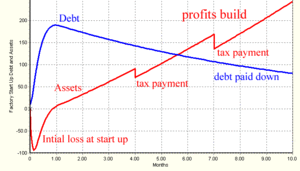Paul Graham's web page
October 2006
In the Q & A period after a recent talk, someone asked what made startups fail.
… If you have a list of all the things you shouldn't do, you can turn that into a recipe for succeeding just by negating. … It's easier to catch yourself doing something you shouldn't than always to remember to do something you should. [
1]
In a sense there's just one mistake that kills startups: not making something users want. … So really this is a list of 18 things that cause startups not to make something users want. …
1. Single Founder
…What's wrong with having one founder? To start with, it's a vote of no confidence. It probably means the founder couldn't talk any of his friends into starting the company with him. That's pretty alarming, because his friends are the ones who know him best.
… Starting a startup is too hard for one person. …[You] need colleagues to brainstorm with, to talk you out of stupid decisions, and to cheer you up when things go wrong.
The last one might be the most important. The low points in a startup are so low that few could bear them alone. When you have multiple founders, esprit de corps binds them together in a way that seems to violate conservation laws. Each thinks "I can't let my friends down." This is one of the most powerful forces in human nature, and it's missing when there's just one founder.
2. Bad Location
Startups prosper in some places and not others. Silicon Valley dominates, then Boston, then Seattle, Austin, Denver, and New York. After that there's not much. …
It's an interesting question why cities
become startup hubs, but the reason startups prosper in them is probably …: that's where the experts are. Standards are higher; people are more sympathetic to what you're doing; the kind of people you want to hire want to live there; supporting industries are there; the people you run into in chance meetings are in the same business. …
3. Marginal Niche
… If you make anything good, you're going to have competitors, so you may as well face that. You can only avoid competition by avoiding good ideas.
I think this shrinking from big problems is mostly unconscious. …Your unconscious won't even let you think of grand ideas. So the solution may be to think about ideas without involving yourself. What would be a great idea for
someone else to do as a startup?
4. Derivative Idea
… If you look at the origins of successful startups, few were started in imitation of some other startup. Where did they get their ideas? Usually from some specific, unsolved problem the founders identified.
…
It seems like the best problems to solve are ones that affect you personally. …
…Instead of starting from companies and working back to the problems they solved, look for problems and imagine the company that might solve them. [
2] What do people complain about? What do you wish there was?
5. Obstinacy
In some fields the way to succeed is to have a vision of what you want to achieve, and to hold true to it no matter what setbacks you encounter. Starting startups is not one of them. … Startups are more like science, where you need to follow the trail wherever it leads.
So don't get too attached to your original plan, because it's probably wrong. Most successful startups end up doing something different than they originally intended—often so different that it doesn't even seem like the same company. …
… Switching to a new idea every week will be equally fatal. … If in each new idea you're able to re-use most of what you built for the previous ones, then you're probably in a process that converges. Whereas if you keep restarting from scratch, that's a bad sign.
Fortunately there's someone you can ask for advice: your users. If you're thinking about turning in some new direction and your users seem excited about it, it's probably a good bet.
6. Hiring Bad Programmers
…So how do you pick good programmers if you're not a programmer? I don't think there's an answer. I was about to say you'd have to find a good programmer to help you hire people. But if you can't recognize good programmers, how would you even do that?
7. Choosing the Wrong Platform
A related problem (since it tends to be done by bad programmers) is choosing the wrong platform. …
Platform is a vague word. It could mean an operating system, or a programming language, or a "framework" built on top of a programming language. It implies something that both supports and limits, like the foundation of a house. …
How do you pick the right platforms? The usual way is to hire good programmers and let them choose. But there is a trick you could use if you're not a programmer: visit a top computer science department and see what they use in research projects.
8. Slowness in Launching
… It takes an effort of will to push through this and get something released to users. [
3]
Startups make all kinds of excuses for delaying their launch. Most are equivalent to the ones people use for procrastinating in everyday life. …
One reason to launch quickly is that it forces you to actually
finish some quantum of work. Nothing is truly finished till it's released; you can see that from the rush of work that's always involved in releasing anything, no matter how finished you thought it was. The other reason you need to launch is that it's only by bouncing your idea off users that you fully understand it.
Several distinct problems manifest themselves as delays in launching: working too slowly; not truly understanding the problem; fear of having to deal with users; fear of being judged; working on too many different things; excessive perfectionism. Fortunately you can combat all of them by the simple expedient of forcing yourself to launch
something fairly quickly.
9. Launching Too Early
Launching too slowly has probably killed a hundred times more startups than launching too fast, but it is possible to launch too fast. The danger here is that you ruin your reputation. You launch something, the early adopters try it out, and if it's no good they may never come back.
… We suggest startups think about what they plan to do, identify a core that's both (a) useful on its own and (b) something that can be incrementally expanded into the whole project, and then get that done as soon as possible. …
The early adopters you need to impress are fairly tolerant. They don't expect a newly launched product to do everything; it just has to do
something.
10. Having No Specific User in Mind
You can't build things users like without understanding them. I mentioned earlier that the most successful startups seem to have begun by trying to solve a problem their founders had. Perhaps … the problems you understand best are your own. [
4]
That's just a theory. What's not a theory is the converse: if you're trying to solve problems you don't understand, you're hosed.
And yet a surprising number of founders seem willing to assume that someone, they're not sure exactly who, will want what they're building. Do the founders want it? No, they're not the target market. Who is? Teenagers. … Or "business" users. What business users? Gas stations? Movie studios? Defense contractors?
You can of course build something for users other than yourself. … But you should realize you're stepping into dangerous territory. …
… When designing for other people you have to be empirical. You can no longer guess what will work; you have to find users and measure their responses. …
 Image via Wikipedia11. Raising Too Little Money
Image via Wikipedia11. Raising Too Little Money
Most successful startups take funding at some point. Like having more than one founder, it seems a good bet statistically. How much should you take, though?
Startup funding is measured in time. Every startup that isn't profitable (meaning nearly all of them, initially) has a certain amount of time left before the money runs out and they have to stop. …
Too little money means not enough to get airborne. What airborne means depends on the situation. Usually you have to advance to a visibly higher level: …It depends on investors, because until you're profitable that's who you have to convince.
So if you take money from investors, you have to take enough to get to the next step, whatever that is. [
5] Fortunately you have some control over both how much you spend and what the next step is. We advise startups to set both low, initially: spend practically nothing, and make your initial goal simply to build a solid prototype. This gives you maximum flexibility.
12. Spending Too Much
It's hard to distinguish spending too much from raising too little. … The only way to decide which to call it is by comparison with other startups. …
… The classic way to burn through cash is by hiring a lot of people. This bites you twice: in addition to increasing your costs, it slows you down—so money that's getting consumed faster has to last longer. …
We have three general suggestions about hiring: (a) don't do it if you can avoid it, (b) pay people with equity rather than salary, not just to save money, but because you want the kind of people who are committed enough to prefer that, and (c) only hire people who are either going to write code or go out and get users, because those are the only things you need at first.
13. Raising Too Much Money
… The problem is not so much the money itself as what comes with it. … If VCs fund you, they're not going to let you just put the money in the bank and keep operating as two guys living on ramen. They want that money to go to work. [
6] At the very least you'll move into proper office space and hire more people. That will change the atmosphere, and not entirely for the better. Now most of your people will be employees rather than founders. They won't be as committed; they'll need to be told what to do; they'll start to engage in office politics.
…
Perhaps more dangerously, once you take a lot of money it gets harder to change direction. … After taking VC money you hire … The more people you have, the more you stay pointed in the same direction.
Another drawback of large investments is the time they take. The time required to raise money grows with the amount. [
7] … VCs never quite say yes or no; they just engage you in an apparently endless conversation. Raising VC scale investments is thus a huge time sink—more work, probably, than the startup itself. And you don't want to be spending all your time talking to investors while your competitors are spending theirs building things.
We advise founders who go on to seek VC money to take the first reasonable deal they get. If you get an offer from a reputable firm at a reasonable valuation with no unusually onerous terms, just take it and get on with building the company. [
8] …
14. Poor Investor Management
As a founder, you have to manage your investors. You shouldn't ignore them, because they may have useful insights. But neither should you let them run the company. …
Pissing off investors by ignoring them is probably less dangerous than caving in to them. … If the founders know what they're doing, it's better to have half their attention focused on the product than the full attention of investors who don't.
How hard you have to work on managing investors usually depends on how much money you've taken. …
If things go well, this shouldn't matter. So long as you seem to be advancing rapidly, most investors will leave you alone. But things don't always go smoothly in startups. Investors have made trouble even for the most successful companies. One of the most famous examples is Apple, whose board made a nearly fatal blunder in firing Steve Jobs. Apparently even Google got a lot of grief from their investors early on.
 Image via Wikipedia15. Sacrificing Users to (Supposed) Profit
Image via Wikipedia15. Sacrificing Users to (Supposed) Profit
… Because making something people want is so much harder than making money from it, you should leave business models for later, just as you'd leave some trivial but messy feature for version 2. In version 1, solve the core problem. And the core problem in a startup is how to
create wealth (= how much people want something x the number who want it), not how to convert that wealth into money.
The companies that win are the ones that put users first. …
It
is irresponsible not to think about business models. It's just ten times more irresponsible not to think about the product.
16. Not Wanting to Get Your Hands Dirty
Nearly all programmers would rather spend their time writing code and have someone else handle the messy business of extracting money from it. …
There's nothing like users for convincing acquirers. It's not just that the risk is decreased. The acquirers are human, and they have a hard time paying a bunch of young guys millions of dollars just for being clever. When the idea is embodied in a company with a lot of users, they can tell themselves they're buying the users rather than the cleverness, and this is easier for them to swallow. [
9]
If you're going to attract users, you'll probably have to get up from your computer and go find some. It's unpleasant work, but if you can make yourself do it you have a much greater chance of succeeding. …[
10] …
If you want to start a startup, you have to face the fact that you can't just hack. At least one hacker will have to spend some of the time doing business stuff.
17. Fights Between Founders
Fights between founders are surprisingly common. …
A founder leaving doesn't necessarily kill a startup, though. Plenty of successful startups have had that happen. [
11] Fortunately it's usually the least committed founder who leaves. …
Most of the disputes I've seen between founders could have been avoided if they'd been more careful about who they started a company with. Most disputes are not due to the situation but the people. … And most founders who've been burned by such disputes probably had misgivings, which they suppressed, when they started the company. Don't suppress misgivings. …The people are the most important ingredient in a startup, so don't compromise there.
18. A Half-Hearted Effort
… Statistically, if you want to avoid failure, it would seem like the most important thing is to quit your day job. Most founders of failed startups don't quit their day jobs, and most founders of successful ones do. …
Does that mean you should quit your day job? Not necessarily. I'm guessing here, but I'd guess that many of these would-be founders may not have the kind of determination it takes to start a company, and that in the back of their minds, they know it. The reason they don't invest more time in their startup is that they know it's a bad investment. [
12]
I'd also guess there's some band of people who could have succeeded if they'd taken the leap and done it full-time, but didn't. I have no idea how wide this band is, but if the winner/borderline/hopeless progression has the sort of distribution you'd expect, the number of people who could have made it, if they'd quit their day job, is probably an order of magnitude larger than the number who do make it. [
13]
… Most startups fail because they don't make something people want, and the reason most don't is that they don't try hard enough.
In other words, starting startups is just like everything else. The biggest mistake you can make is not to try hard enough. To the extent there's a secret to success, it's not to be in denial about that.
Notes
[
1] This is not a complete list of the causes of failure, just those you can control. There are also several you can't, notably ineptitude and bad luck.
[
2] Ironically, one variant of the Facebook that might work is a facebook exclusively for college students.
[
3] Steve Jobs tried to motivate people by saying "Real artists ship." This is a fine sentence, but unfortunately not true. Many famous works of art are unfinished. It's true in fields that have hard deadlines, like architecture and filmmaking, but even there people tend to be tweaking stuff till it's yanked out of their hands.
[
4] There's probably also a second factor: startup founders tend to be at the leading edge of technology, so problems they face are probably especially valuable.
[
5] You should take more than you think you'll need, maybe 50% to 100% more, because software takes longer to write and deals longer to close than you expect.
[
6] Since people sometimes call us VCs, I should add that we're not. VCs invest large amounts of other people's money. We invest small amounts of our own, like angel investors.
[
7] Not linearly of course, or it would take forever to raise five million dollars. In practice it just feels like it takes forever.
Though if you include the cases where VCs don't invest, it would literally take forever in the median case. And maybe we should, because the danger of chasing large investments is not just that they take a long time. That's the
best case. The real danger is that you'll expend a lot of time and get nothing.
[
8] Some VCs will offer you an artificially low valuation to see if you have the balls to ask for more. It's lame that VCs play such games, but some do. If you're dealing with one of those you should push back on the valuation a bit.
[
9] Suppose YouTube's founders had gone to Google in 2005 and told them "Google Video is badly designed. Give us $10 million and we'll tell you all the mistakes you made." They would have gotten the royal raspberry. Eighteen months later Google paid $1.6 billion for the same lesson, partly because they could then tell themselves that they were buying a phenomenon, or a community, or some vague thing like that.
I don't mean to be hard on Google. They did better than their competitors, who may have now missed the video boat entirely.
[
10] Yes, actually: dealing with the government. But phone companies are up there.
[
11] Many more than most people realize, because companies don't advertise this. Did you know Apple originally had three founders?
[
12] I'm not dissing these people. I don't have the determination myself. I've twice come close to starting startups since Viaweb, and both times I bailed because I realized that without the spur of poverty I just wasn't willing to endure the stress of a startup.
[
13] So how do you know whether you're in the category of people who should quit their day job, or the presumably larger one who shouldn't? I got to the point of saying that this was hard to judge for yourself and that you should seek outside advice, before realizing that that's what we do. We think of ourselves as investors, but viewed from the other direction Y Combinator is a service for advising people whether or not to quit their day job. We could be mistaken, and no doubt often are, but we do at least bet money on our conclusions.
Thanks to Sam Altman, Jessica Livingston, Greg McAdoo, and Robert Morris for reading drafts of this.









 Wayne Turmel is obsessed with helping organizations and their managers communicate better, even across cyberspace. He's a writer, a speaker, the president of
Wayne Turmel is obsessed with helping organizations and their managers communicate better, even across cyberspace. He's a writer, a speaker, the president of 


 Kimberly Weisul is a freelance writer, editor and editorial consultant. She was most recently a senior editor at
Kimberly Weisul is a freelance writer, editor and editorial consultant. She was most recently a senior editor at 

 [Image: Flickr user
[Image: Flickr user 















